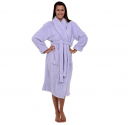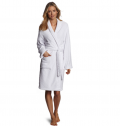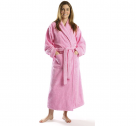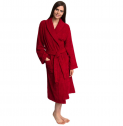There’s nothing quite like stepping out of the shower into a warm, fuzzy bathrobe. It gives you that fancy spa feeling every time. Shopping for a bathrobe might sound straightforward at first, but there’s more to it than meets the eye. There are all sorts of lengths and materials available, so how do you decide which one you need?
At BestReviews, we’re here to do the leg work for you!
If you’re ready to buy a bathrobe now, please consider our highlighted favourites. But if you’d like to learn a bit more about bathrobes before you make your final decision, please continue reading this shopping guide.
Alexander Del Rossa Women’s Microfiber Fleece
Seven Apparel Spa Collection, Herringbone Textured
Turkishtowels 100% Combed Turkish Cotton
TowelSelections Turkish Terry, 100% Egyptian Cotton
WHY BUY A BATHROBE?
If you’ve existed all these years without a bathrobe, you might be wondering why you would need one.
Here’s the lowdown:
Wearing a bathrobe is probably the easiest way to dry off after a bath or shower. Just slip it on, continue about your business, and you’ll be dry within minutes.
We all know the agony of leaving a glorious hot shower for a chilly bathroom. If you step into your bathrobe immediately, however, you’ll retain most of your heat.
Bathrobes are comfy for lounging around the house after your bath or shower.
To keep warm, many people wear bathrobes over pyjamas before climbing into bed.
- Bathrobes are excellent for kids, especially little ones who wriggle around when you’re trying to dry them off.
MATERIALS
Bathrobes come in a range of materials. Let’s take a look at some of the most common bathrobe fabrics.
Terry cloth
Terry cloth — sometimes known as cotton terry or towelling — is the same material from which bath towels are made. With its long, absorbent fibres, terry cloth is the ideal material for drying yourself off after a bath, shower, or swim. Notably, terry cloth can lose some of its softness over time.
Satin or silk
Silk and satin robes aren’t absorbent at all. They’re designed for relaxation rather than drying yourself off after a bath. Many people enjoy wearing a sleek, silky robe over their nightwear.
Cotton waffle
As the name suggests, this is a fabric made from cotton. But instead of being thick and plush, it’s a lightweight, densely woven material with a square or diamond waffle pattern. Although it’s not quite as absorbent as terry cloth, it still does a good job of getting the wearer dry, and it’s less bulky than other bathrobe types.
Cotton velour
Cotton velour robes feel a lot like velvet, but the material absorbs more moisture and has a thicker pile. This is, by far, the softest type of cotton bathrobe, so if comfort is high on your priority list, you may wish to investigate your cotton velour options. Like terry cloth bathrobes, however, they are quite bulky.
Microfibre
Microfibre bathrobes are soft and fleece-like. Despite the fact that they’re made of synthetic material, microfibre robes actually “breathe” more than most robes made of natural materials. Microfibre bathrobes are also very lightweight and absorbent.
CONSIDERATIONS
Length
The majority of bathrobes are designed to be knee length, mid-calf length, or ankle length. Remember when you’re shopping, however, that “knee length” for one person of is “mid-thigh” for another.
For this reason, you should evaluate your potential garment in terms of its length in centimetres. The manufacturer will present these details in the robe’s specifications. Then you’ll know for sure how long the robe will be on you.
Size
Most bathrobes are sized as small, medium, large, extra-large, and so on. The trouble with this is that there’s no standardisation between brands, so a small bathrobe from one manufacturer might fit a size 0, whereas a small from another manufacturer might fit a size 4.
Where possible, look at the manufacturer’s size chart before making your purchase. The chart may provide you the measurements for each size in centimetres. Alternatively, it may provide comparable dress sizes for each bathrobe size.
Colour
Today’s bathrobes come in a rainbow of colours, so you can pick whichever hue captures your fancy.
Some consumers like the fresh, clean look of a white bathrobe. Others prefer a darker colour, which is more forgiving in case of staining. And some prefer to match their bathrobe with the rest of their bath linens.
PRICE
You can find a bathrobe to suit just about any budget.
Basic bathrobes sell for as little as $15 to $20. And while a bargain robe will do its job just fine, the material is likely to be of lower quality. What’s more, the overall construction probably won’t be as good. You could end up finding tears or holes at the seams after just a year or two of use.
Robes that cost $30 to $40 tend to be of a decent quality — and some are downright luxurious. If you opt for cotton, you’re bound to find a nice cotton robe in this middle range.
For the utmost in quality, you’re looking at paying $50+. A luxury bathrobe like this should be made of only the finest materials, such as Egyptian or Turkish cotton. You might raise an eyebrow at the price, but a robe of this quality is a sound investment that should last for years to come.
TIPS
Microfibre is a catch-all name for synthetic materials in which each fibre is roughly 1/5 the diameter of a human hair.
The microfibres used for bathrobes are chosen for their softness and high absorbency.
- Cotton is a popular material for bathrobes, as many buyers prefer to wear natural fibres over synthetics.
FAQ
Q. How is Egyptian cotton different from other types of cotton?
A. Some consumers view Egyptian cotton as the most luxurious bathrobe material available. Its long fibres can be spun into dense threads, making it extremely absorbent — an important quality in a bathrobe, to be sure.
But Egyptian cotton isn’t the only fantastic cotton out there. Turkish cotton also serves as an excellent bathrobe material. The fibres aren’t quite as dense and absorbent as Egyptian cotton, but they grow softer and fluffier over time. If you favour comfort over absorbency, Turkish cotton is probably your best bet.
Q. Do bathrobes usually have pockets?
A. Not all bathrobes have pockets, but some do. Whether you want pockets in your robe is up to you. If you plan to wear it around the house, pockets could come in handy. But if you plan to wear it only after you get out of the shower, pockets probably aren’t needed.
Q. Do all bathrobes have tie fastenings?
A. Most bathrobes have a single tie or belt fastening. However, there are other types of bathrobe fastenings out there, including zips and buttons.












